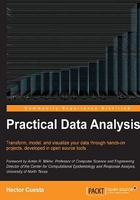
Chapter 3. Data Visualization
Sometimes, we don't know how valuable data is until we look at it. In this chapter, we get into a Web Visualization Framework called D3 (Data-Driven Documents) to create visualizations that make complex information easier to understand.
In this chapter we will cover:
- Data-Driven Documents (D3)
- Getting started with D3.js
- Bar chart
- Pie chart
- Scatter plot
- Line chart
- Multi-line chart
- Interaction and animation
Exploratory data analysis (EDA) as mentioned in Chapter 1, Getting Started, is a critical part of the data analysis process because it helps us to detect mistakes, determine relationships and tendencies, or check assumptions. In this chapter, we present some examples of visualization methods for EDA with discrete and continuous data.
The four types of EDA are univariate non-graphical, multivariate non-graphical, univariate graphical, and multivariate graphical. The non-graphical methods refer to the calculation of summary statistics or the outlier detection. In this book, we will focus on the univariate and multivariate graphical models. Using a variety of visualization tools such as bar chars, pie charts, scatter plots, line charts, and multi-line charts, all implemented in D3.js.
In this chapter, we will work with two types of data: discrete data with a list of summarized pokemon types (see Chapter 2, Working with Data), and hand with continuous data using the historical exchange rates from March 2008 to March 2013. We also explore the creation of a random dataset.